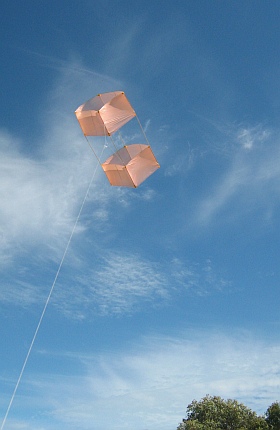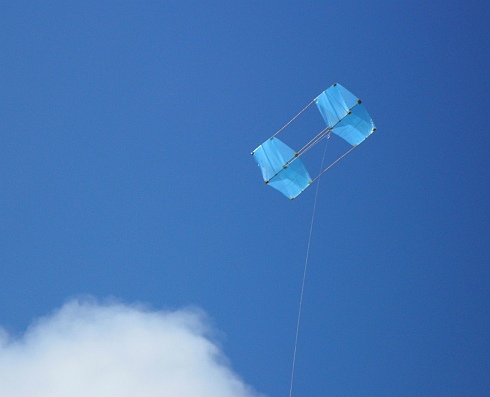A History of Box Kites From Hargrave To The EO6
Early in the history of box kites, they were used mainly for lifting.
Lawrence Hargrave, the inventor of the box kite in 1892, used to link
several together and even hoisted a very trusting human under the
largest of them!

For most of the history of Box kites, someone has flown one just for fun!
Samuel Cody, from the United States, later extended the rectangular box concept and made some winged box kites that were designed for the military. Cody patented his man-lifting system in 1901.
The idea was that a human observer could provide an advantage on the battlefield, by observing the enemy from a great height. The wings and vanes made the kites even more stable and suited to lifting heavy objects.
Actually, somebody did once go up under a Cody kite to more than 2000 feet of altitude! Too bad the airplane was invented not many years later... A whole bunch of perfectly good Cody kites ended up in moth-balls.
On the topic of airplanes, notice how similar the oldest of biplanes were to box kites. The planes were basically box-kites with a tail and an engine added. No coincidence. Take for example, the Bristol Boxkite, a famous old aircraft. The earliest plane inventors, including the Wright brothers, tinkered with kites while they planned and dreamt about what they really wanted to build!
Later in the history of box kites, during the early twentieth century, they were used for measuring atmospheric conditions such as wind velocity, temperature, barometric pressure and humidity at a range of altitudes. These were large, with oiled silk sails and steel lines. Nice and stable with great lifting power.
Another military application that can be found in box kite history is the emergency kits issued to pilots in the Second World War, in the 1940s. Called the Gibson-Girl Box Kite, it could be flown by a pilot lost at sea, with it's line acting as the aerial for a radio transmitter. So if there was no wind, I guess the pilot had to paddle his life raft like a lunatic, while trying to make the radio call at the same time. I'm getting exhausted just thinking about it.
Just about the whole time all this military stuff was going on, and up to this day, radio enthusiasts have used box kites for hoisting up aerials to a great height! I guess ham radio isn't as big as it once was, but there you have it, another application for box kites.
Another application that has been going on for quite some time is KAP, or Kite Aerial Photography. Designs based on the box kite are nice and stable in the air and so are ideal for mounting photographic gear. Mind you, these days weight isn't such an issue with lipstick cams and similar tiny devices being available! There are even some kits around that include kite, camera and other necessary bits and pieces.
Since the year 2000, the history of box kites has seen a general trend for greater and greater variety in the weird and wonderful. Spectacular, colorful, multi-celled, tumbling and rotating works of aerial art! An example is the EO6, a commercially produced kite that is unstable in light winds. The flier has fun by deliberately slackening and pulling the line to make the kite tumble and change direction.

Home-made designs can look a little plainer, like my Dowel Box for fresh winds, below... But it's still a blast to see your own creation scooting around up there, hauling the line tight in a fresh breeze!
The MBK Dowel Box kite. This is the fresh wind version in flight.
National Kite Festival Events
International Kite Festival Events
Kite Flying Competition
Kite Flying Training for Students.
Kite Flying for Individual Private Marriage Functions, Corporate Events, School Competition and Special Occasions.
Kite Fighting Competition
Kite Making Competition
Inter School Kite Competition
Kite Painting
Kite Exhibition and Knowledge Programm
kite club india
Please contact me on vibrantkiteclub@gmail.com with details.
http://vibrantkiteclub.com/
91-9898194208
source by - http://www.my-best-kite.com/history-of-box-kites.html

For most of the history of Box kites, someone has flown one just for fun!
Samuel Cody, from the United States, later extended the rectangular box concept and made some winged box kites that were designed for the military. Cody patented his man-lifting system in 1901.
The idea was that a human observer could provide an advantage on the battlefield, by observing the enemy from a great height. The wings and vanes made the kites even more stable and suited to lifting heavy objects.
Actually, somebody did once go up under a Cody kite to more than 2000 feet of altitude! Too bad the airplane was invented not many years later... A whole bunch of perfectly good Cody kites ended up in moth-balls.
On the topic of airplanes, notice how similar the oldest of biplanes were to box kites. The planes were basically box-kites with a tail and an engine added. No coincidence. Take for example, the Bristol Boxkite, a famous old aircraft. The earliest plane inventors, including the Wright brothers, tinkered with kites while they planned and dreamt about what they really wanted to build!
Later in the history of box kites, during the early twentieth century, they were used for measuring atmospheric conditions such as wind velocity, temperature, barometric pressure and humidity at a range of altitudes. These were large, with oiled silk sails and steel lines. Nice and stable with great lifting power.
Another military application that can be found in box kite history is the emergency kits issued to pilots in the Second World War, in the 1940s. Called the Gibson-Girl Box Kite, it could be flown by a pilot lost at sea, with it's line acting as the aerial for a radio transmitter. So if there was no wind, I guess the pilot had to paddle his life raft like a lunatic, while trying to make the radio call at the same time. I'm getting exhausted just thinking about it.
Just about the whole time all this military stuff was going on, and up to this day, radio enthusiasts have used box kites for hoisting up aerials to a great height! I guess ham radio isn't as big as it once was, but there you have it, another application for box kites.
Another application that has been going on for quite some time is KAP, or Kite Aerial Photography. Designs based on the box kite are nice and stable in the air and so are ideal for mounting photographic gear. Mind you, these days weight isn't such an issue with lipstick cams and similar tiny devices being available! There are even some kits around that include kite, camera and other necessary bits and pieces.
Since the year 2000, the history of box kites has seen a general trend for greater and greater variety in the weird and wonderful. Spectacular, colorful, multi-celled, tumbling and rotating works of aerial art! An example is the EO6, a commercially produced kite that is unstable in light winds. The flier has fun by deliberately slackening and pulling the line to make the kite tumble and change direction.

Home-made designs can look a little plainer, like my Dowel Box for fresh winds, below... But it's still a blast to see your own creation scooting around up there, hauling the line tight in a fresh breeze!
The MBK Dowel Box kite. This is the fresh wind version in flight.
National Kite Festival Events
International Kite Festival Events
Kite Flying Competition
Kite Flying Training for Students.
Kite Flying for Individual Private Marriage Functions, Corporate Events, School Competition and Special Occasions.
Kite Fighting Competition
Kite Making Competition
Inter School Kite Competition
Kite Painting
Kite Exhibition and Knowledge Programm
kite club india
Please contact me on vibrantkiteclub@gmail.com with details.
http://vibrantkiteclub.com/
91-9898194208
source by - http://www.my-best-kite.com/history-of-box-kites.html











0 comments: